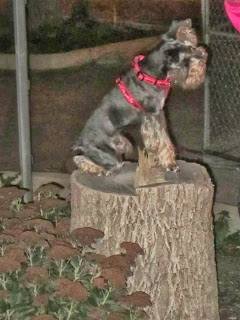There are probably quite a few of you out there that have done agility long enough to encounter the dreaded teeter monster of agility class lore. Some of your dogs may be convinced that it is a obstacle specifically designed to destroy their very being where others of you are anxiously awaiting that fateful day when your dog first encounters the teeter of doom.
Well, there is good news for you!
It is completely possible to use the skills you might learn in Urban Agility to help your dog learn that the teeter isn’t a scary obstacle and could even be considered FUN! It takes just a few simple steps and once you have these well mastered, you should be well on your way to a fast, confident teeter performance.
The things that scare most dogs about the teeter is that it MOVES (gasp, that can’t be good! I’m going to fall to my doom!) and it makes NOISE (things that make noise have been scientifically proven to eat dogs, don’t you know??). We can use this knowledge to design a plan that teaches our dogs that things that move and make noise are good.
Are you ready for that? Good.
 1) Teach your dog to stand on things. At this point they should be things that are solid and won’t move when he steps or jumps onto them. Good objects to look for are stairs, platforms, walls, loading docks, etc. Repeat until he is confidently jumping on everything you ask of him.
1) Teach your dog to stand on things. At this point they should be things that are solid and won’t move when he steps or jumps onto them. Good objects to look for are stairs, platforms, walls, loading docks, etc. Repeat until he is confidently jumping on everything you ask of him.
2) Gradually introduce objects that move. Start with things that move a VERY LITTLE bit and don’t make noise when they do so. This can be things like cardboard boxes, laundry baskets, etc. Be sure the object is appropriate for his size, and is safe. You can gradually increase the movement of these objects. Little kid toys with wheels seem to work very well (and you end up with some pretty cute tricks too!). Reinforce your dog everytime he gets onto one of these objects and it moves.
3) Teach your dog that making noise is a good thing. Teach your dog to knock over or touch objects that might make some noise. Good things for this are tarps, bags, mugs, water bottles etc. Remember to reinforce with delicious treats or a fun game every time he makes noise. Gradually find things that make more noise. We have found placing metal objects inside other metal objects makes the most racket.
 4) Now combine the two skills. Find objects that both make noise AND move. Be creative here and try to find as many different objects as possible. The more things you find, the more comfortable your dog is going to be when introduced to a teeter. It will simply be one of those “weird things that move and bang around to give me cookies.”
4) Now combine the two skills. Find objects that both make noise AND move. Be creative here and try to find as many different objects as possible. The more things you find, the more comfortable your dog is going to be when introduced to a teeter. It will simply be one of those “weird things that move and bang around to give me cookies.”
5) Find teeter like objects. Be sure to find objects that move like a teeter. Placing a pool noodle under a board will do this, as well as finding a seesaw at your local playground.
6) Repeat this WHOLE process with a real teeter. Teach your dog to walk on a plank, then teach him to make it make noise, and to move it, then put the moving and the noise together at a low height. Gradually increase the height until you can show off how much your dog loves the full teeter to all of your very jealous friends. The more work you do in the previous steps, the faster this one will go, so do your homework!
This video will give you a brief introduction into the first few steps of training a teeter:




.JPG)








